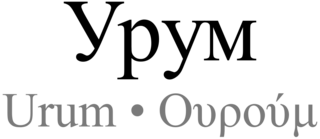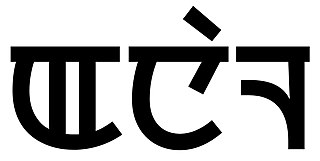Related Research Articles

Ambrym is a volcanic island in Malampa Province in the archipelago of Vanuatu. Volcanic activity on the island includes lava lakes in two craters near the summit.

Urum is a Turkic language spoken by several thousand ethnic Greeks who inhabit a few villages in southeastern Ukraine. Over the past few generations, there has been a deviation from teaching children Urum to the more common languages of the region, leaving a fairly limited number of new speakers. The Urum language is often considered a variant of Crimean Tatar.

Anāl, also known as Namfau after the two principal villages it is spoken in, is a Northern Kukish language, part of the Sino-Tibetan language family, spoken by the Anal people in India and a dwindling number in Burma. It had 13,900 speakers in India according to the 2001 census, and 50 in Burma in 2010. The speakers of this language use Meitei language as their second language (L2) according to the Ethnologue.

Bora is an indigenous language of South America spoken in the western region of Amazon rainforest. Bora is a tonal language which, other than the Ticuna language, is a unique trait in the region.
The Central Vanuatu languages form a linkage of Southern Oceanic languages spoken in central Vanuatu.

Gaua is the largest and second most populous of the Banks Islands in Torba Province in northern Vanuatu. It covers 342 km2.
Sa or Saa language is an Austronesian language spoken in southern Pentecost Island, Vanuatu. It had an estimated 2,500 speakers in the year 2000.
Gorowa is a Cushitic language spoken in Tanzania in the Dodoma and Manyara Regions.
Moxo is any of the Arawakan languages spoken by the Moxo people of the Llanos de Moxos in northeastern Bolivia. The two extant languages of the Moxo people, Trinitario and Ignaciano, are as distinct from one another as they are from neighboring Arawakan languages. The extinct Magiana was also distinct.
Karko is a Hill Nubian language spoken in the northwestern Nuba Mountains in the south of Sudan. It is spoken by around 7,000 people in the Karko hills, 35 km west of Dilling, including Dulman, although Jakobi Angelika & Hamdan Ahma estimate the Karko population at up to 15,000 individuals, mostly in urban centers. Ethnologue reports that speakers of Karko are shifting to Sudanese Arabic.
Sümi, also Sema, is a Sino-Tibetan language spoken in Nagaland, India. It is spoken by the Sümi Naga people. It differs from every other Naga languages due to the presence of guttural sounds.
Jahai (Jehai) is an aboriginal Mon–Khmer language spoken by the Jahai people living in the montane rainforests of northern Peninsular Malaysia and southernmost Thailand. It is the largest Northern Aslian language. Though spoken by only a little more than 1,000 people, Jahai does not appear to be in immediate danger of extinction due to the prevalence of Jahai parents passing on the language to their children as their mother tongue.
Kakabe is a Mande language of Guinea. The speakers of the Kakabe language reside in the Futa-Jallon plateau which is located in Guinea. Kakabe belongs to the Mokole group, which is the closest group to the Manding people in terms of culture and language. The language is spoken in a number of villages that are situated on the Futa-Jallon plateau in Guinea.
Ruuli is the Bantu language spoken by the Baruuli and Banyala people of Uganda primarily in Nakasongola and Kayunga districts. It is closely to the Nyoro language
Southeast Ambrym, Vatlongos, or Taveak, is a language of Ambrym Island, Vanuatu. It is closely related to Paamese.
North Ambrym is a language of Ambrym Island, Vanuatu.
Lonwolwol, Raljago, or West Ambrym, is an Oceanic language of Ambrym Island, Vanuatu with fewer than 100 speakers.
Port Vato, locally known as Daakie, is a language of Ambrym Island, Vanuatu.
Nisvai is an Oceanic language spoken in southeast Malekula, Vanuatu, on the eastern tip of the island, by about 200 speakers.
Dalkalaen is a Central Vanuatu language spoken by about 1,000 people on the southwestern tip of Ambrym Island, Vanuatu.
References
- ↑ Fanbyak at Ethnologue (25th ed., 2022)

- ↑ Change request documentation for fbk.